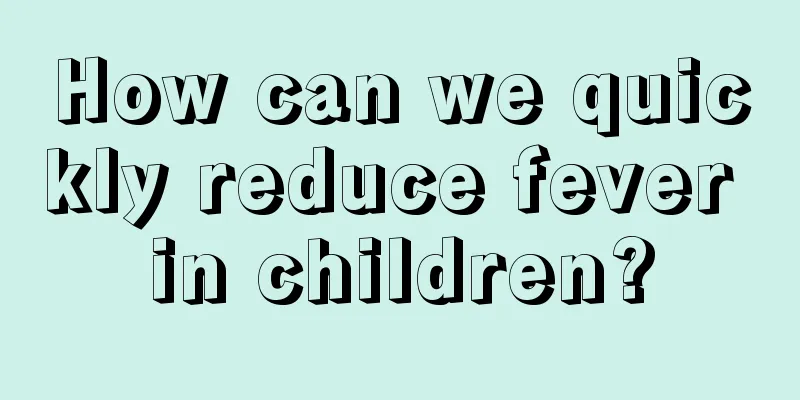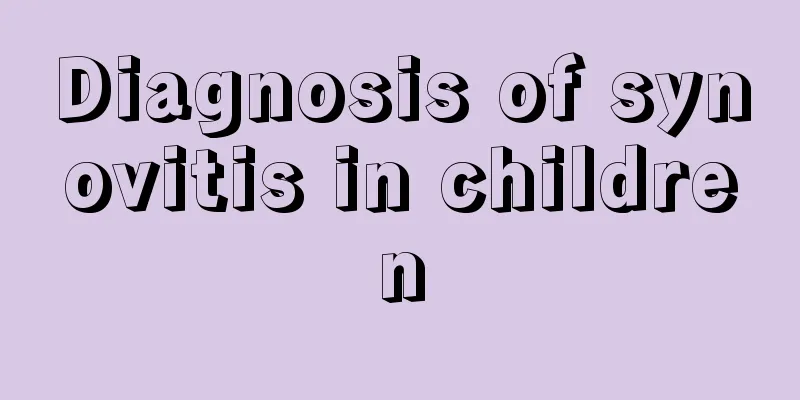How can we quickly reduce fever in children?

|
Nowadays, many people often suffer from headaches and fever due to poor physical resistance. Many people think that headaches and fever can be treated by taking medicine. However, fever not only occurs in adults, but is also a common disease in children. Children with fever need to pay attention to reducing fever, otherwise the fever will be very serious. When it reaches 39 degrees, it may cause meningitis and affect the body's resistance. When children have a fever, they must pay attention to reducing fever. It is not relieved by taking medicine. First of all, physiological cooling should be done to maintain the temperature in the greenhouse. Don't cover too much, because the heat cannot evaporate, which will cause the body temperature to continue to rise. As parents, you should also pay attention to the precautions when using ice pillows in the process of reducing children's fever. 1. What is fever? The relative stability of human body temperature is achieved under the regulation of the body temperature regulation center. It is generally believed that a rectal temperature (rectal temperature) above 38°C is called fever, and the oral and axillary temperatures are 0.5 and 0.8°C lower than the rectal temperature, respectively. Fever is both a symptom of a disease and one of the body's protective responses against infection. When the body is invaded by foreign pathogenic microorganisms (exogenous pyrogens) or the release of certain substances in the body (endogenous pyrogens) increases, producing a fever effect, the body temperature regulation center will move the temperature setting point upward, causing the heart rate to increase, skeletal muscles to contract, etc., thereby increasing heat production; at the same time, the terminal blood vessels will contract and the sweat pores will close, reducing heat dissipation and causing the body temperature to rise. According to the changes and increases in the contradiction between heat production and heat dissipation, fever is generally divided into four stages: prodromal stage, temperature rising stage, high temperature sustained stage, and temperature dropping stage. 2. The pros and cons of fever Medical research shows that various immune function (i.e. human resistance) indicators in the human body are better when the body has a fever than when the body temperature is normal. This is the body's emergency mobilization of various resistance forces to fight against foreign pathogenic microorganisms and adjust the body's physiological balance. In this sense, fever is a natural self-protective reflex. Of course, fever can also be harmful to the human body. Persistent high fever can increase the burden on the heart and lungs, damage cells and organ function, and induce excessive immune response and convulsions. Therefore, should the fever be reduced, when should the fever be reduced, and how should the fever be reduced? You need to weigh the pros and cons and make a scientific choice. 3. How to deal with fever in different situations Various causes can cause fever, the most common of which is infection by various pathogenic microorganisms. Treating fever and treating the cause must be done at the same time. Whether to give antipyretic treatment needs to be decided based on weighing the possible pros and cons. The World Health Organization recommends that in general antipyretic treatment should only be used for children with high fever, that is, the rectal temperature is 39°C or above. The goal of reducing fever is not to return the body temperature to "normal" immediately, but to lower it to a safe range or level that has a positive protective effect on the body. For children with low to moderate fever who are in good general condition and have no other underlying diseases, strong antipyretic treatment is not recommended. Appropriate physical cooling can be used. For children with persistent high fever or fever with underlying diseases (such as febrile convulsions, epilepsy, severe heart, brain, and lung diseases), active antipyretic treatment should be used. Is it suitable to use ice pillow to cool down children with fever? Ice pillow cooling is one of the commonly used physical cooling methods. It uses local ice compresses to lower the temperature of the head. The specific method is: place an ice bag or ice pillow on the forehead or behind the head. If there are no special ice bags or ice pillows, you can put the ice in a hot water bottle or plastic bag. In emergency, you can use popsicles instead. However, not all children with fever are suitable for cooling with an ice pillow, and the same baby may not be suitable for cooling with an ice pillow at different stages of fever. So, what are the precautions when implementing ice pillow cooling? ① Children under 6 months old should not use ice pillows to cool down. Because the body temperature of a baby is easily affected by the external temperature, for many babies, when they have a fever, the body temperature can be lowered by simply reducing the amount of clothing and bedding. If ice packs are used, excessive cooling may occur, resulting in problems such as body temperature not rising. If the body temperature does not drop after reducing the amount of clothing and bedding, you can take a warm water bath. ② It is not advisable to use an ice pillow to cool down the child when his body temperature is rising. When the body temperature is in the rising stage, the blood vessels in the skin are in a state of contraction, and the temperature of the skin surface is lowered, which manifests as pale skin, cold limbs, and chills. At this time, you should pay attention to keeping the limbs warm and feed some boiled water. At this time, if physical cooling measures such as ice pillows or alcohol baths are used, the peripheral blood vessels may further contract, poor peripheral circulation may occur, which is not conducive to the body's heat dissipation and may even further increase the body temperature. ③When using an ice pillow to cool down, do not allow it to directly contact the skin. Use a towel or handkerchief between the skin and the ice pack or ice pillow to prevent the child from feeling uncomfortable or local tissue frostbite. In addition, ice pillows or ice packs should not be placed on the chest and abdomen to prevent a slow heart rate or diarrhea. ④ During the cooling process with the ice pillow, if the child has cold reactions such as cold hands and feet, shivering whole body, purple lips, etc., stop using the ice pillow immediately. |
<<: How to properly regulate children’s weak spleen and stomach?
>>: Can childhood tics be cured?
Recommend
How to clean baby's stool
If infants and young children have bad bowel move...
What causes a hoarse throat in children?
Parents will find that some children have a whirr...
How to care for 8-month-old baby with cold and stuffy nose
The baby's immunity is relatively weak, and c...
What causes a rash after a baby has a fever?
We all know that babies are in a period of rapid ...
90-day baby development standard
Many parents do not fully understand the developm...
Can children eat pearl powder?
Pearl powder is a traditional Chinese medicine. I...
What should I do if my child has a curved spine?
If a child has a curved spine, it is most likely ...
Neonatal urachal fistula
A urachal fistula usually occurs in newborns and ...
What should we pay attention to when measuring C-protein in children with rheumatic fever?
Children's body resistance is relatively low ...
Early symptoms of purpura in children
The early symptoms of purpura in children mainly ...
What to do if the child's temperature is below 36 degrees
The child's body temperature is lower than 36...
Why do babies have repeated fevers and what should parents do?
After all, babies are very young, so their physic...
Can newborns use humidifiers?
In our lives, many families use air humidifiers, ...
What are the white spots on the newborn baby's face?
Many newborns have small white spots on their fac...
Can babies with cerebral palsy be amused? This is the truth!
Babies with cerebral palsy have relatively low fu...









